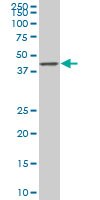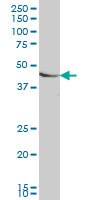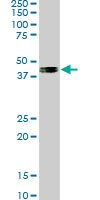biological source
mouse
Quality Level
antibody form
purified antibody
antibody product type
primary antibodies
clone
4E1, monoclonal
form
liquid
does not contain
preservative
species reactivity
human
manufacturer/tradename
Calbiochem®
storage condition
OK to freeze
avoid repeated freeze/thaw cycles
isotype
IgG2a
shipped in
wet ice
storage temp.
−20°C
target post-translational modification
unmodified
Gene Information
human ... SMAD7(4092)
General description
Purified mouse monoclonal antibody. Recognizes the ~40-45 kDa SMAD7 protein.
Recognizes the ~40-45 kDa SMAD7 protein in HeLa and U-2 OS cells and human placenta tissue.
This Anti-SMAD7 Mouse mAb (4E1) is validated for use in Immunoblotting for the detection of SMAD7.
Immunogen
A recombinant polypeptide corresponding to amino acids of 160-261 human SMAD7, expressed as a GST fusion protein
Application



Immunoblotting (1-5 g/ml)
Physical form
In PBS, pH 7.2.
Preparation Note
Following initial thaw, aliquot and freeze (-20°C).
Analysis Note
Positive Control
Human placenta tissue, HeLa cells, U-2 OS cells
Human placenta tissue, HeLa cells, U-2 OS cells
Other Notes
Variables associated with assay conditions will dictate the proper working dilution.
Legal Information
CALBIOCHEM is a registered trademark of Merck KGaA, Darmstadt, Germany
Disclaimer
Toxicity: Regulatory Review (Z)
Not finding the right product?
Try our Product Selector Tool.
Storage Class Code
12 - Non Combustible Liquids
WGK
nwg
Flash Point(F)
Not applicable
Flash Point(C)
Not applicable
Certificates of Analysis (COA)
Search for Certificates of Analysis (COA) by entering the products Lot/Batch Number. Lot and Batch Numbers can be found on a product’s label following the words ‘Lot’ or ‘Batch’.
Already Own This Product?
Find documentation for the products that you have recently purchased in the Document Library.
Chih-Hau Chang et al.
International journal of molecular sciences, 18(9) (2017-09-08)
Restoring sufficient vascularity of the ischemia/hypoxia flap is always the critical issue in flap surgeries. In a previous studies microRNA-21 (miR-21) expression was upregulated after rat skin flap surgery. MiR-21 has been reported to be induced by hypoxia and the
Genaro Rodríguez-Uribe et al.
BioMed research international, 2018, 2847873-2847873 (2018-06-12)
This work aimed to determine if cataractous changes associated with EMT occurring in the K14E6 mice lenses are associated with TGF-β and Wnt/β-catenin signaling activation. Cataracts of K14E6 mice were analysed histologically; and components of TGF-β and Wnt/β-catenin signaling were
Chi-Ting Su et al.
Human molecular genetics, 24(14), 4024-4036 (2015-04-18)
Mutations in the gene for the latent transforming growth factor beta binding protein 4 (LTBP4) cause autosomal recessive cutis laxa type 1C. To understand the molecular disease mechanisms of this disease, we investigated the impact of LTBP4 loss on transforming
Our team of scientists has experience in all areas of research including Life Science, Material Science, Chemical Synthesis, Chromatography, Analytical and many others.
Contact Technical Service